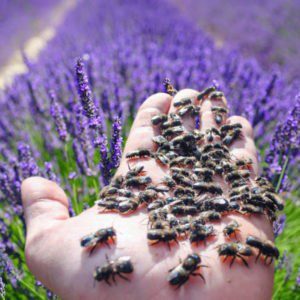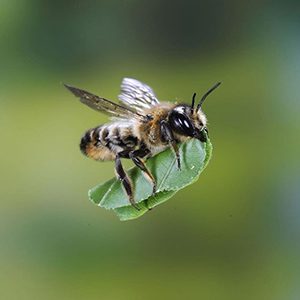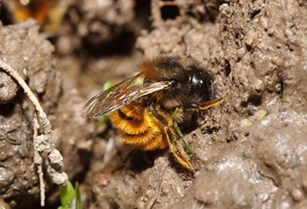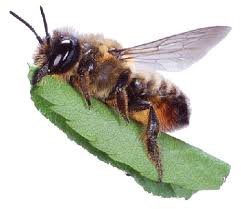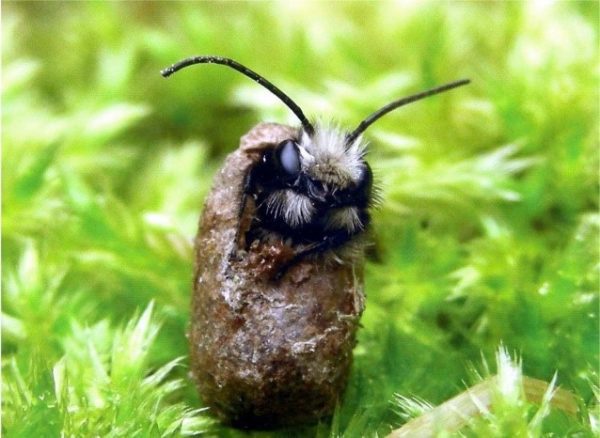Guide to Raising Mason Bees
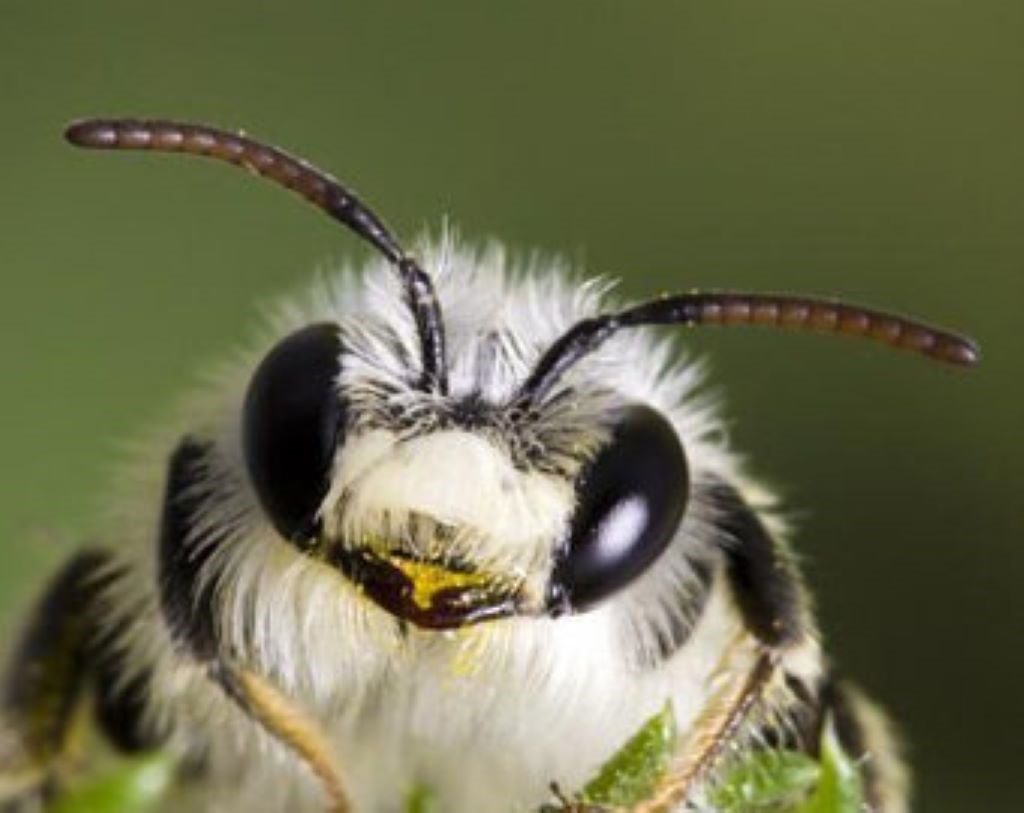
How To successfully raise Stingless
Blue Mason Bees, and Summer Leaf Cutter Bees.
To successfully raise Mason Bees, you must shadow manage the two seasons, of their life cycles. The time they are active and the time they sleep. When they are active you must provide, ensure, that they have wildflowers or fruit trees, a nest, that will provide shelter from wind and rain, and mud if your pollinators are Mason Bees, and soft leaves like lilac leaves for nest construction.
When they are inactive you must ensure that they have a safe-haven. A place to sleep, to hibernate, in their silk cocoons. And a storage container, that acts as a humidifier with around 60 to 70% humidity, which is maintained between 38-42 degrees F.
Wildflowers, a nest, and mud when active.
A safe box to sleep in.
These are very easy to provide, for well under a hundred dollars, and that includes the Mason Bees.
But First
When you first put Mason Bees in your garden, there is an emotional component, watching them work, pollinating your apples, and pears, bring a feeling of pleasure, that is hard to describe. It is like have a pet.
Over time though you can’t help looking over the fence. You see there is a component, that is bigger than you. A world outside your garden.
We’ve all seen a moth drawn to a single flame. The lights of cities and towns magnify that response in insects, pulling them out of their natural environment, it’s called light pollution. They are migrating to urban environments and need a place to find food and shelter. It’s hard for them to find food in an asphalt parking lot, of a WinCo store. They need sanctuaries; wildflowers, in your yards and gardens. And then there’s Colony Collapse.
What Is “Colony Collapse Disorder” and is there-Hope.
The next few paragraphs deal with a global catastrophe that threatens 1/3 of the world food supply, a brief history of pollination, the honeybee’s role in it, and how you can make a huge difference.
We must have a backup plan. Mason bees and summer Leaf Cutter Bees; are the backup team.
You can skip ahead to the-How to Section. If you need too.
Thanks for doing your part.
THE PROBLEM AND THE SOLUTION.
The winter of 2019 Colony Collapse continued unabated. Colony losses were horrendous. Highest losses since records have been kept.
Honeybees didn’t exist in the Americas before the pilgrim’s arrival. Before 1950 Honeybees were used for honey; not pollination. In the 1950s, we unintentionally whipped out almost all our native bee species.
We were forced to turn to the Honeybee; for pollination. Now the Honeybee is disappearing. This alarming decline of bee populations is causing panic in the agriculture, and food industries.
It’s not just the honeybee.
MASON BEES, NATIVE POLLINATOR, BIRDS AND BUTTERFLIES are in Big Trouble, they are on the knife-edge of “Extinction.
Mason Bees have all but been wiped out in most countries in the world. We have only a few Mason Bees left in breeding programs. In the United States, scientists recently found the population of monarch butterflies fell by 90 percent in the last 20 years, a loss of 900 million individuals; the rusty-patched bumblebee, which once lived in 28 states, dropped by 87 percent over the same period. A study last year showed a 76 percent decrease in native bee populations, over the past decade, in a German nature preserves.
Now birds are in danger. Nearly 3 Billion Birds are Gone Since 1970. All told, the North American bird population is down by 2.9 billion breeding adults,
The extinction of bees and birds is a predictor of our demise. Think global warming is an issue, we need to wake up and smell the wildflowers flowers.
The real message here is that our birds, our pollinators have lost their habitat, where they lived, where they thrived is gone. 94% of America’s natural habitat has been turned into highways, parking lots, wheat fields, corn and soybean crops, forest lands, pasture, and golf courses.
We can’t expect farmers to solve the problem, most of the time they are operating on thin margins. If they stop using; fertilizers, herbicides, fungicides, and pesticides, they will go under, and us with them.
But there is Hope!
THE SOLUTION
We can use American’s Largest Single ‘Crop.’ Our Lawns! In the U.S. there are 180,000,000 million acres of lawns. 900 million homes can be planted with a strip of wildflowers that provides a highway across every city, and every state in North America!
They have already begun this process in Alberta prairies, and it is working.
Pollinator Sanctuaries is simple, innovative, low cost, long-term, sustainable and environment-friendly
We can’t safely raise Honeybees in our back yards, but we can raise Mason Bees and Leaf Cutter Bees, they are our backup plan. We can repopulate North America, with native bees, North America original pollinators.
And Mason Bees and Leaf Cutter bees are more efficient pollinators than the honeybee. A 100 Mason Bees or Leaf Cutter Bees can perform the work of 10,000 Honeybees.
By small things are great thing brought to pass.
We are at the top of the food chain, but if it collapses under us; then what.
How it works
Plant small plots, in your gardens and flower beds, using various combinations of annual and perennial wildflowers, with varying and overlapping flowering periods to increase the bee foraging ability beyond that of a short agricultural season. A continuous and uninterrupted supply of nectar and pollen over the entire spring and summer.
Why Wildflowers, it’s the pollinators’ natural food. Some wildflowers have lots of nectar, some lots of pollen, some high protein pollen, some medicated pollen, the bees will fly were they need too.
Wildflowers are very different from the modern hybrid flowers you have in your yard. Test it yourself. Take a Heritage Rose, and a modern (very lovely) hybrid rose and smell each one. That the difference, the essential oils, the protein content of the pollen, the richness of the nectar.
To the Mason Bees, the butterflies, bumblebees, and 4000 other native pollinators wildflowers are essential; wildflowers are their food and their medicine chest.
Wildflower–rich area is critical to saving, bringing back, mason bees, bumblebees, and butterflies. In a two-year study in England, researchers collected DNA from 2000 bumblebees. They found that the bees’ chance of surviving to the next year increased by up to 400% when they had access to strips of wildflowers.
Once You’ve planted the flowers, now add in your Mason Bees and Leaf Cutter bees.
They will nurture and promote a highly successful wildflower garden that will be attracting rich biodiversity, wild honeybees, native bees (like bumblebees, solitary bees, leaf-cutter bees, and Mason Bees), as well as other friendly pollinators like butterflies.
From each backyard plot, pollinators will spread and expand across North America. If you sow, in due seasons, we will reap.
By small things are great thing brought to pass.
You can outsource your wildflowers and create your mix or you can order a Mix of Wildflowers, Mason Bees, Leaf Cutter bees and nesting supplies from our web site, https://www.rockypondnursery.com/ which is under construction or on our pages on eBay https://www.ebay.com/usr/rockypond-masonbees-lavender or Esty https://www.etsy.com/shop/RockyPondNursery?ref=seller-platform-mcnav
WILDFLOWERS? WHY THE MASON BEE?
Five hundred wildflower seed per packet. Bee-Kind wildflower mix has been specifically blended to bloom early and long, providing food for Mason Bees and newly emerging bumblebee queens. Pollinators need help! If every home had even a small area of wildflowers in their flower beds.
Buy and plant early-blooming wildflowers, your Mason Bees will tend them, and every pollinator will make use of them.
The Mason Bee and summer Leaf Cutter bees are the only native pollinator that we have successfully adapted to help us. With the continuing collapse of the Honey Bees, we must have an alternative, a backup, or we lose 1/3 of the food- in our stores.
How to raise Blue Mason Bees and summer Leafcutter Bees.
Unlike honeybees you’ll need, only 15 minutes to set up, Mason Bee and Summer Leafcutter Bees take very little effort or time to set up. You’ll need the following:

Flowers and/or fruit trees, blueberry bushes, etc.
Mason Bees and/or Summer Leafcutter Bees
Mason Bees and Leaf Cutter Bees have one trait that honeybees do not have and will not do-They will work inside a greenhouse or in the fields.
Confine honeybees inside a greenhouse, say a greenhouse growing tomatoes, and they will bludgeon themselves to death, banging their heads against the plastic sides of the greenhouse. Mason Bees and Summer Leaf Cutter bees will just go to work pollinating.
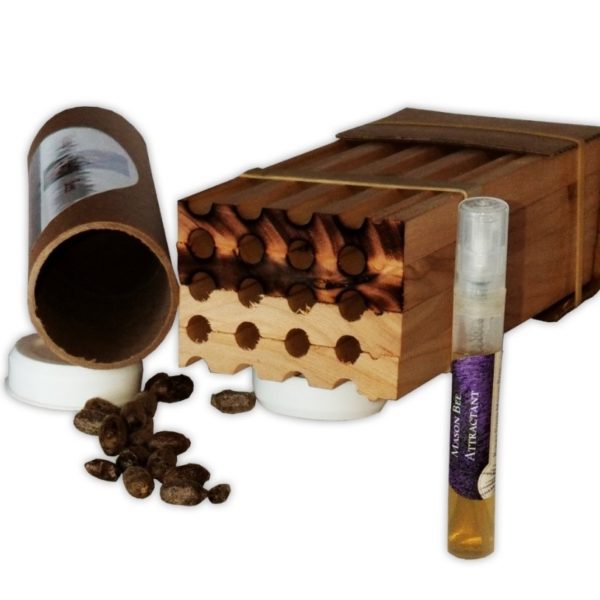
Attractant, a release tube, and a Nesting Block.
A cleanable nesting block is imperative. If you use Kraft paper tubes or bamboo tubes
your bees will perish the second season. Every season they need clean nesting sites;
cleaning these take apart nesting blocks, takes just minutes.
Spray your block and shelter with attractant, Mason Bees and Summer Leafcutter bees
like to nest where it smells like home.
Birds of a feather fly together.
So do bees.
It is very important to have nesting materials close to your nesting site-critical or the bees will abandon the nest site. Have mud or leaves within 15-25 feet of nesting spots.
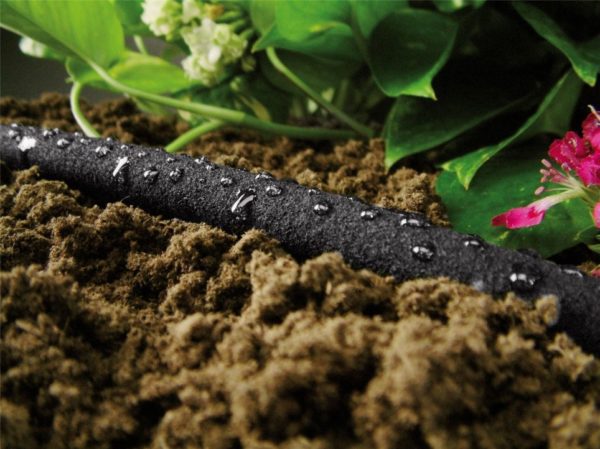
Mud
Mud is critical for Mason Bees. We use a soaker hose and a battery-operated timer to keep the mud continually moist near the nesting site.
I’ve often marveled at how well-planned pollination is in nature. In early spring we have mason bees that utilize mud when leaves may not yet be on the fruit trees.
In the dryer summer months, we have summer Leafcutter Bees that utilize leaves, when moist mud may be hard to come by.
If you have sandy soils, that don’t stick together when you squeeze them, add some organic garden soil from one of the box stores.
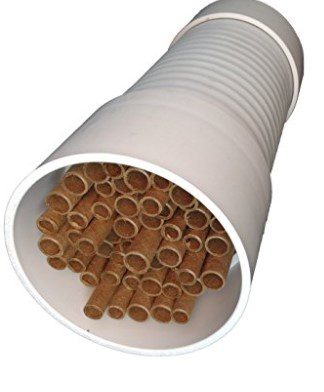
Shelter
An old coffee can will work, all the outer covering is for, is to protect the nesting tubes from the weather. We have found an inexpensive piece of 3-4-inch PVC pipe, from your local hardware store, and a PVC cap works just fine and all, for under $5.00.
Face the opening of towards the morning sun, your bees will sit on the lip and warm up in the morning, before they go to work.
We never seem to have enough bees.
Many of you pre-order your Mason Bees; to ensure that you have bees come spring. You can store them in your garage or shop anywhere the temperature will stay between freezing and fifty degrees, and they will hibernate till spring.
If you want to use them in the fall, such as in a greenhouse put them where the temperature will be around 60 degrees and they will hatch in about two to three weeks.
When your release tube and your Blue Mason Bees arrive from Rocky Pond – Mason Bees. They will come in a Bubble Mailers Padded Envelopes.
If you order Mason Bees after March 15th a few of the males may have already hatched, when you receive them, so expect a few hatched bees with most still in their cocoons.
If some of the male bees have hatched, Take the release tube to your nest and pull off the tape and release the males, that have hatched, they will hang around for two to three weeks, so they can breed the females.
Put the remainder of the males and female cocoons in the refrigerator, if by chance it’s more than 3 weeks don’t worry you have plenty of males.
If none of the bees have hatched yet, you can store them up and until May 1st before putting them out.
But remember if the temperature is 55 degrees and over, they may hatch anytime. To prevent this, put the release tube in a humidifier bee safe, then in your refrigerator, which stays a consistent 34-40 degrees, but your refrigerator humidity is way to low, by storing them in a simple humidifier, your cocoons won’t dry out. You can store them up and until May 1st or when the daytime temperature is consistently 55 degrees or more.
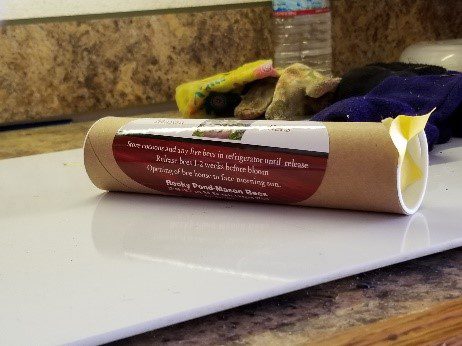
Each species of bee will work for 6-8 weeks. For longer pollination season stagger you’re your release date. Release 20 bees March 1st and another 20 April 1st and 10 more April 15th. The same applies to summer leafcutter bees; start June 1st and go from there.
When you are ready to take a release tube to the nest and put the release tube, in the protective cover, in this case, a coffee can remove the tape covering the exit hole.
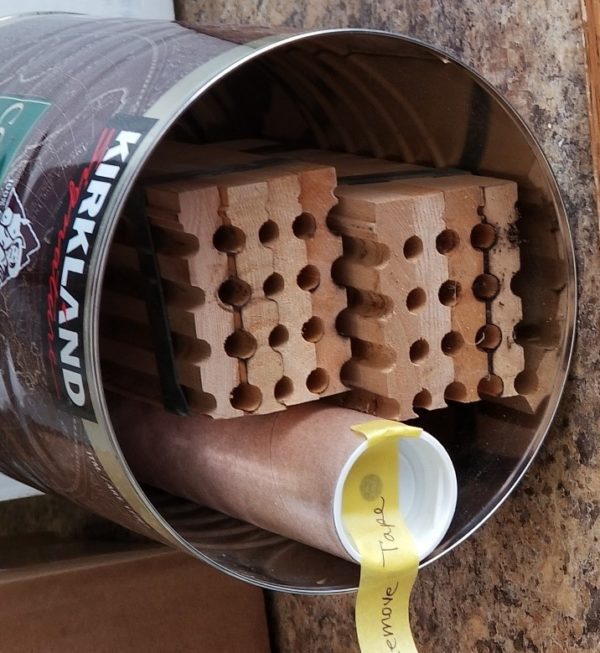
After two to three weeks, remove the release tube and add more nesting blocks if you have them.
If your temperature is consistently over 85 degrees or there is no mud you might want to switch to summer Leafcutter Bees.
The End of the pollination season. Harvest your Cocoons and store them in a humid and chilled environment.
When your bees have stopped all activity, do not move them for 30 days or you will dislodge the fragile eggs. After 30 days move them into your garage or shed for storage.
In October or November, if you are working on Mason Bees and February if Leaf Cutter bees, take your nest block apart and with a potato peeler.
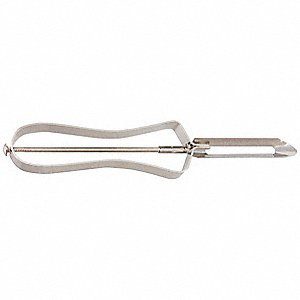
Scoop the cocoons and dirt out of the grooves of nesting block.
Brush out the nesting block and spray with Mason bee or Leafcutter Bee attractant. Attractants act as prep for next season and as an antiseptic to kill mold and mildew.
Wash the cocoons, with a spray of water, while they are in a strainer until the water runs clear.
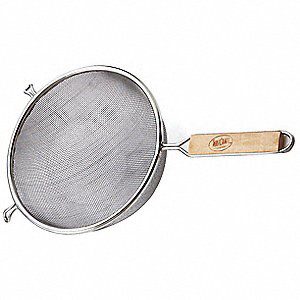
Set cocoons on a paper towel and let them dry. When dry, put them back in the Humidifier bee-safe till next spring.
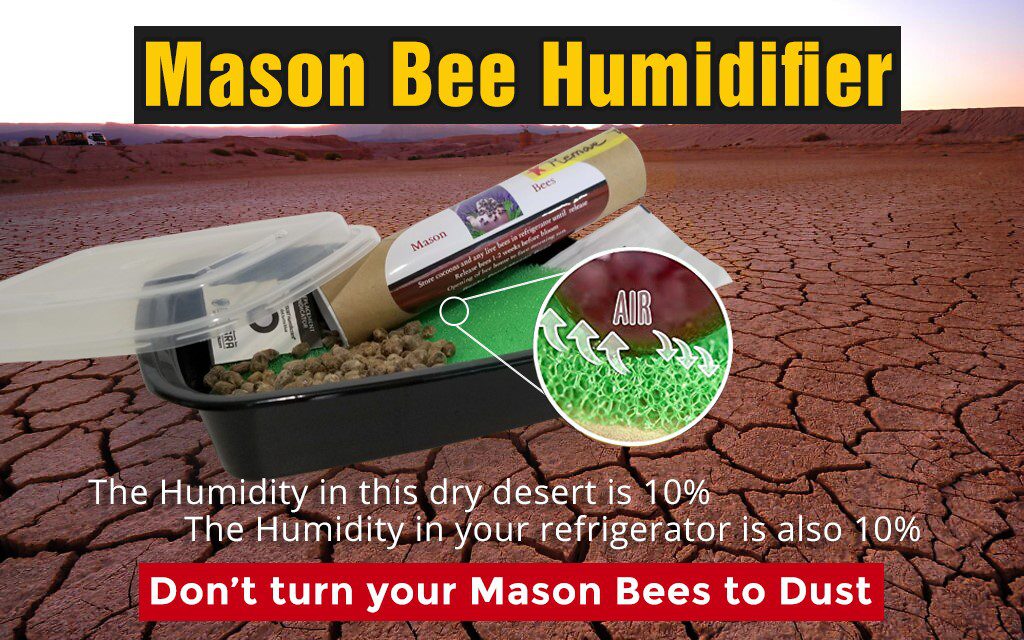
Storing Mason Bee Cocoons
Mason bee cocoons overwintered in a 34-38F (1-3C) controlled environment (your refrigerator) consume their stored fats much slower than in fluctuating outdoor temperatures and emerge stronger and ready to go to work, in the spring. Plus, you can hold them longer in your refrigerator, so you can control your release dates.
The only problem is that your refrigerator has a very low humidity around 10-20% and your cocoons will dehydrate, dry up and your bees will die.
To solve that problem, get, a BPA-Free and Food-Grade Safe box, put a larger sponge in it, add a little water to the sponge side, (so the sponge is moist, not soaked) and put a double layer breathable matrix on the other side that is antifungal, for your cocoons to rest on. Put this Bee-Safe in the refrigerator. This will maintain humidity for your Mason Bee cocoons at around 75%. Add water to sponge every three-month.

